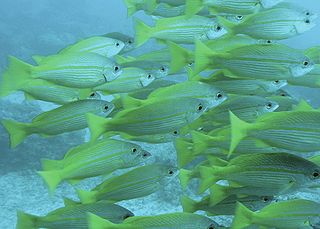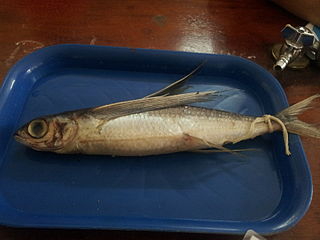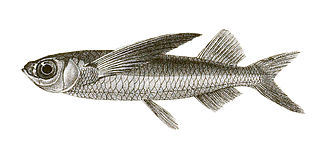
Cirrhitidae, the hawkfishes, are a family of marine ray-finned fishes found in tropical seas and which are associated with coral reefs.

The Exocoetidae are a family of marine ray-finned fish in the order Beloniformes, known colloquially as flying fish or flying cod. About 64 species are grouped in seven genera. While they cannot fly in the same way a bird does, flying fish can make powerful, self-propelled leaps out of the water where their long wing-like fins enable gliding for considerable distances above the water's surface. The main reason for this behavior is thought to be to escape from underwater predators, which include swordfish, mackerel, tuna, and marlin, among others, though their periods of flight expose them to attack by avian predators such as frigate birds.

Exocoetus is a genus of flying fishes. It is a bony fish. The body is covered with cycloid scales. The mouth is wide, and the jaws bear teeth. It is a marine fish. The tail has hypobatic fins as the ventral lobe.

Cypselurus is a genus of flying fish in the family Exocoetidae. They are found across Indo-Pacific to western Atlantic ocean.

Cheilopogon is a genus of flyingfishes. They are found worldwide except the Antarctic and Arctic oceans.

Cirrhitichthys is a genus of marine ray-finned fish, hawkfishes, from the family Cirrhitidae. They are found on tropical reefs in the Indian and western Pacific oceans. Some species can be found in the aquarium trade.

The California flying fish, Cheilopogon pinnatibarbatus californicus, is a subspecies of Bennett's flying fish, Cheilopogon pinnatibarbatus. Prior to the 1970s, the California flying fish was known as a distinct species, with the scientific classification Cypselurus californicus. The California flying fish is one of 40 distinct classifications of flying fish. It is the largest member of the flying fish family, growing up to 19 inches (48 cm) in length. It is a marine species found in the Eastern Pacific Ocean, from Oregon to Baja California. As with all other flying fish, the California can not actually fly, it launches itself into the air, using its specially adapted fins to glide along the surface. The California flying fish spends most of its time in the open ocean but comes close to shore at night to forage and lay eggs in the protection of kelp beds.

Lutjanus is a genus of marine ray-finned fish, snappers belonging to the family Lutjanidae. They are found in the Atlantic, Indian, and Pacific Oceans. They are predatory fish usually found in tropical and subtropical reefs, and mangrove forests. This genus also includes two species that only occur in fresh and brackish waters.

The coral hawkfish, the pixy hawkfish or sharp-headed hawkfish, is a species of marine ray-finned fish, a hawkfish belonging to the family Cirrhitidae. It is native to tropical reefs of the Indian Ocean and the Pacific Ocean. It occasionally is found in the aquarium trade.

The mirrorwing flyingfish is a flying fish of the family Exocoetidae. It was first described by the French zoologist, Achille Valenciennes in a 22-volume work titled Histoire naturelle des poissons, which was a collaboration with Georges Cuvier.

The Atlantic flyingfish is a flying fish in the family Exocoetidae. The flyingfish fauna is made up of 16 total species, 6 of which belong to the genus Cheilopogon, including C. melanurus. The Atlantic flyingfish is also in the order Beloniformes and class Actinopterygii. It was first described by the French zoologist, Achille Valenciennes in a 22-volume work entitled Histoire naturelle des poissons, which was a collaboration with fellow zoologist Georges Cuvier.

Hyporhamphus is a genus of halfbeaks. The species in this genus are distributed throughout the warmer seas of the world, most species being Indo-Pacific and there are some freshwater species.
Prognichthys is a genus of flying fishes. They are Widespread in tropical oceans.

Pristipomoides is a genus of marine ray-finned fish belonging to the family Lutjanidae, the snappers. They are found in the Atlantic, Indian and Pacific oceans.

Cheilopogon nigricans, the blacksail flyingfish, also known as African flyingfish, or leaping flyingfish, is a flying fish in the family Exocoetidae. It is an oceanodromous, plankton-eating marine fish which has commercial value.

Parexocoetus mento; also known as the African sailfin flying fish, Cuvier's flying fish, the yellow belly flying fish or the short-winged flying fish; is a species of flying fish from the family Exocoetidae which is found in the Indo-pacific region and which has colonised the eastern Mediterranean.

Exocoetoidea is a superfamily of fishes that comprises three families, the flying fishes, the halfbeaks and the viviparous halfbeaks. They are found in tropical and subtropical waters around the world. Exocoetoidea is part of the suborder Exocoetoidei of the order Beloniformes.

Hirundichthys rondeletii, the black wing flyingfish, is a species of flying fish from the family Exocoetidae which is found throughout the tropical and subtropical waters of the Atlantic, Pacific and Indian Oceans.
Exocoetus peruvianus, commonly known as the Peruvian flyingfish, is a species of ray-finned fish endemic to the tropical southeast Pacific Ocean in the waters off Peru and Ecuador.
Cheilopogon papilio, the butterfly flyingfish, is a species of ray-finned fish within the family Exocoetidae, distributed in the eastern Pacific off the coasts of Mexico in Baja California and the Revillagigedos Islands, as well as some areas off Costa Rica and Panama. Other common names of the species include the exocet papillon in French and volador mariposa in Spanish.

















